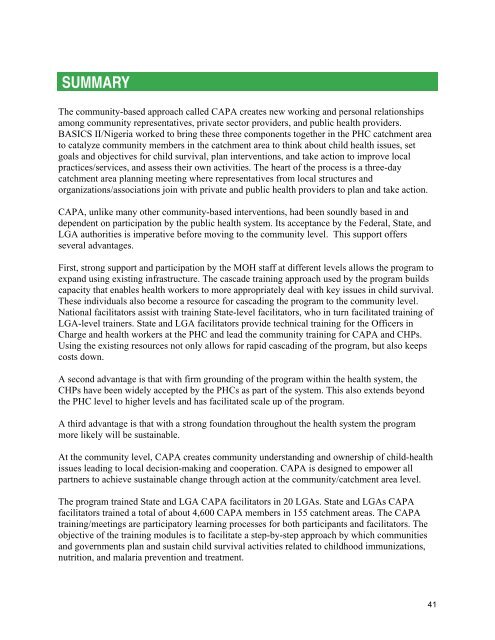The CAPA Handbook: A "How-to" Guide for Implementing ... - basics
The CAPA Handbook: A "How-to" Guide for Implementing ... - basics
The CAPA Handbook: A "How-to" Guide for Implementing ... - basics
Create successful ePaper yourself
Turn your PDF publications into a flip-book with our unique Google optimized e-Paper software.
SUMMARY<br />
<strong>The</strong> community-based approach called <strong>CAPA</strong> creates new working and personal relationships<br />
among community representatives, private sector providers, and public health providers.<br />
BASICS II/Nigeria worked to bring these three components together in the PHC catchment area<br />
to catalyze community members in the catchment area to think about child health issues, set<br />
goals and objectives <strong>for</strong> child survival, plan interventions, and take action to improve local<br />
practices/services, and assess their own activities. <strong>The</strong> heart of the process is a three-day<br />
catchment area planning meeting where representatives from local structures and<br />
organizations/associations join with private and public health providers to plan and take action.<br />
<strong>CAPA</strong>, unlike many other community-based interventions, had been soundly based in and<br />
dependent on participation by the public health system. Its acceptance by the Federal, State, and<br />
LGA authorities is imperative be<strong>for</strong>e moving to the community level. This support offers<br />
several advantages.<br />
First, strong support and participation by the MOH staff at different levels allows the program to<br />
expand using existing infrastructure. <strong>The</strong> cascade training approach used by the program builds<br />
capacity that enables health workers to more appropriately deal with key issues in child survival.<br />
<strong>The</strong>se individuals also become a resource <strong>for</strong> cascading the program to the community level.<br />
National facilitators assist with training State-level facilitators, who in turn facilitated training of<br />
LGA-level trainers. State and LGA facilitators provide technical training <strong>for</strong> the Officers in<br />
Charge and health workers at the PHC and lead the community training <strong>for</strong> <strong>CAPA</strong> and CHPs.<br />
Using the existing resources not only allows <strong>for</strong> rapid cascading of the program, but also keeps<br />
costs down.<br />
A second advantage is that with firm grounding of the program within the health system, the<br />
CHPs have been widely accepted by the PHCs as part of the system. This also extends beyond<br />
the PHC level to higher levels and has facilitated scale up of the program.<br />
A third advantage is that with a strong foundation throughout the health system the program<br />
more likely will be sustainable.<br />
At the community level, <strong>CAPA</strong> creates community understanding and ownership of child-health<br />
issues leading to local decision-making and cooperation. <strong>CAPA</strong> is designed to empower all<br />
partners to achieve sustainable change through action at the community/catchment area level.<br />
<strong>The</strong> program trained State and LGA <strong>CAPA</strong> facilitators in 20 LGAs. State and LGAs <strong>CAPA</strong><br />
facilitators trained a total of about 4,600 <strong>CAPA</strong> members in 155 catchment areas. <strong>The</strong> <strong>CAPA</strong><br />
training/meetings are participatory learning processes <strong>for</strong> both participants and facilitators. <strong>The</strong><br />
objective of the training modules is to facilitate a step-by-step approach by which communities<br />
and governments plan and sustain child survival activities related to childhood immunizations,<br />
nutrition, and malaria prevention and treatment.<br />
41

















